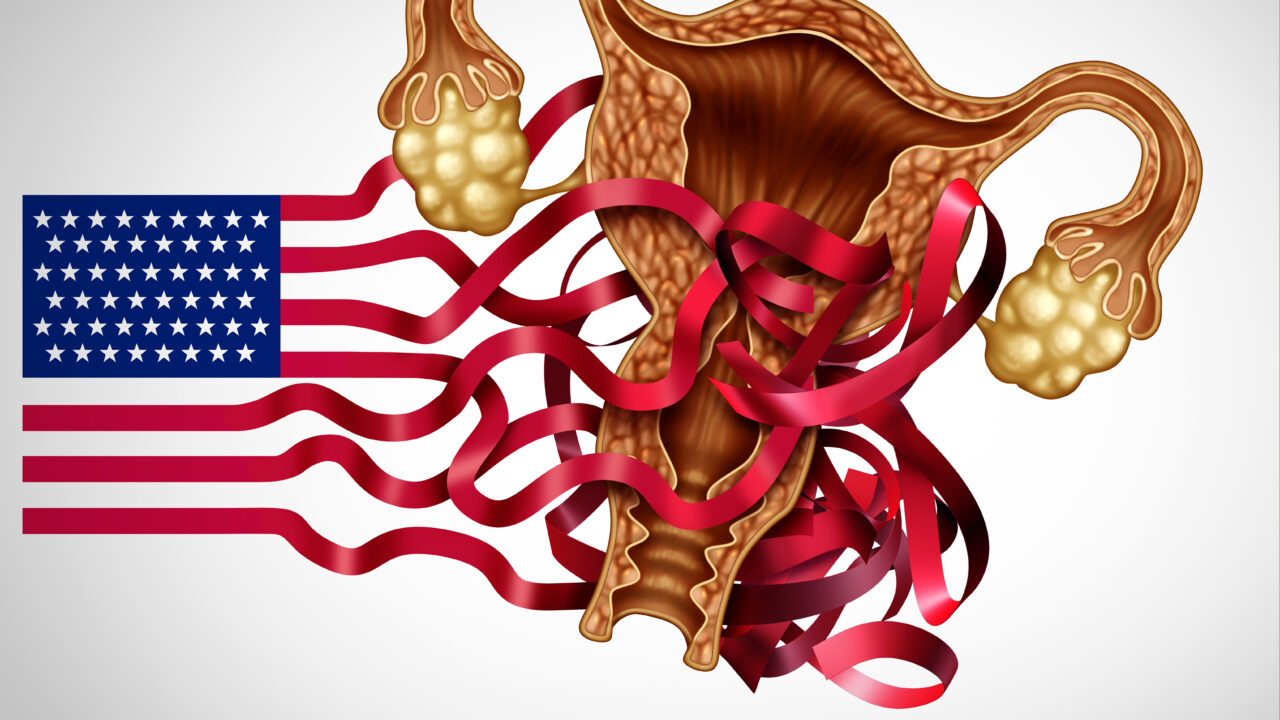Abortion After Dobbs: Harder and More Dangerous Across the Country
Amid high costs and major delays in care, abortions in second and third trimester are on the rise. More GOP-led states are leaning into so-called gestational compromises. Image: Adobe
More GOP-led states are leaning into so-called gestational compromises. Image: Adobe
In April, a Reddit user in Alabama posted a breathless message to the abortion subreddit the morning after learning she was pregnant. She guessed she was early, two or three weeks maybe.
“There’s a clinic in GA about 3 hours away. They said they will do it as long as no heartbeat is found on the ultrasound. If they find a heartbeat what do I do then??”
Alabama, where abortion is a crime, is surrounded by states with abortion bans. But nearby Georgia currently allows a tiny window, which shuts once the embryo’s cardiac activity registers on an ultrasound. This happens generally by six weeks’ gestation, and the user was running out of time. And now she was sick to her stomach and passing gelatinous blood clots.
This very active subreddit is moderated around the clock by the Online Abortion Resource Squad, a group of mostly volunteers that debunk abortion misinformation and help users navigate a labyrinth of abortion bans and restrictions. The end of federal abortion rights changed access nationwide. Even ending a wanted pregnancy is now more difficult based on your income, how far along you are, and your state’s ever-changing abortion laws.
In a plot twist for the user in Alabama, it turned out she had likely miscarried. “UPDATE!!!!! My uterus is empty,” she wrote. “Basically alabama politicians made me drive across state lines and pay $250 because I was too scared to go to my regular doctor .”
But then there’s the Reddit user who described weeping in a Planned Parenthood clinic because her pregnancy measured just a few days beyond its 19.6-week cutoff. Staff helped her make an appointment at another clinic. “I really want this to be over with,” she wrote. “Now to just figure out transportation for next Saturday. Easy enough. *fingers crossed*”
It’s been a year since the U.S. Supreme Court ruled in Dobbs v. Jackson Women’s Health Organization that states could criminalize all or most abortions, and now 15 states fully or mostly ban the procedure, while others have begun enacting gestational limits and other restrictions. That’s left the hundreds of thousands of U.S. women and minors who annually seek abortions forced to travel if they can, overwhelming the abortion clinics in states where it’s legal. This has led to astronomical patient costs and major care delays.
As a result, abortions in the second and third trimester of pregnancy appear to be on the rise, abortion providers, public health researchers, and patient advocates told States Newsroom. Many patients, they say, are experiencing the higher risks of complication, anxiety, and trauma that sometimes come with abortion later in pregnancy. And advocates say this situation is likely to get worse, with an abortion-provider shortage and states continuing to throw up new legislative barriers.
“Right now, in any state, there’s just no scenario where people aren’t getting delayed because of wait times for appointments,” said Ariella Messing, a PhD candidate in bioethics and health policy from Johns Hopkins University, who founded OARS.
Messing told States Newsroom she spends about 80 hours a week managing the abortion subreddit and helping connect people to abortion providers and financial and practical support. OARS has been monitoring the subreddit since 2019, but activity spiked after Texas outlawed most abortions in 2021. Since Dobbs, it’s exploded. Messing said OARS decided to keep r/abortion open during the Reddit blackout protest.
Some of the abortion cases are so complicated and medically necessary that Messing, who previously worked as a case manager for the Baltimore Abortion Fund, personally gets involved, sometimes spending a whole day trying to help someone desperate to terminate a pregnancy under a ticking clock.
The woman for whom it took eight weeks to terminate a pregnancy that had become dangerous kept Messing up at night, until that person terminated, finally, at 27 weeks.
“This wasn’t how they should be getting care – by a random stranger on Reddit,” Messing said.
Part of the problem is that so few clinics in the U.S., especially post Dobbs, go beyond 20 weeks’ gestation.
While the true extent to which Dobbs has prevented people from getting abortions remains to be seen, emerging research suggests that women and minors are increasingly unable to end a pregnancy, especially people of color and people living in poverty.
The Society of Family Planning has been measuring the number of abortions reported by abortion clinics and hospitals. In the nine months after the Dobbs decision, the rate of medication abortion jumped, but overall, providers reported more than 25,000 fewer abortions nationwide.
The Society’s latest #WeCount report did not capture how many people self-managed outside the formal health care system, or how far along patients were. But University of California San Francisco professor Ushma Upadhyay, who co-chairs the #WeCount project, said it would be logical for gestational ages to be rising, given the increased obstacles in accessing care quickly.
Additionally, brand-new research from the university’s Advancing New Standards in Reproductive Health program finds a nationwide increase in providers offering abortion later in gestation than they were previously due to rising demand, as well as more clinics offering telehealth medication abortion. But the demand is still overshadowing the need, especially later in pregnancy.
“The states where there are bans now, there were very few clinics in those states, because there were so many restrictions,” Upadhyay said. “But those clinics that were open did offer abortion care till later, usually midway of the second trimester. … So, right now there’s huge swaths of the country where later abortion is simply unavailable.”
Part of the problem is that so few clinics in the U.S., especially post Dobbs, go beyond 20 weeks’ gestation. The vast majority are independent clinics not part of the Planned Parenthood network, which has more resources and political clout than the independents.
There is a tiny cluster of clinics that provide abortions in the third trimester, on a case-by-case basis. One is in Boulder, Colorado, and the others are concentrated in and around Washington D.C., which has become a major national abortion destination.
Abortion providers say they are scheduling visits weeks out.
“Anecdotally, we are seeing in some places, people are being pushed, or people are having to delay their care, and it has resulted in people having procedures one to two weeks later than they then we saw the previous year,” said Melissa Fowler, chief program officer of the National Abortion Federation, which provides resources for abortion clinics and funds some patient costs. “And of course, we’re also seeing a delay with people who need later care as well.”
Dr. Sarah Traxler, the chief medical officer for Planned Parenthood North Central States, testified before the Minnesota lawmakers back in March about a 40% rise in second-trimester cases since Dobbs. The region encompasses Iowa, Minnesota, Nebraska, North Dakota, and South Dakota, with the bulk of patients going to Minnesota.
“Since June, I have cared for patients from everywhere,” Traxler testified. “I’ve seen patients who’ve flown from Louisiana, only to find that their complex pregnancy condition kept them from being seen in a freestanding clinic like mine, forcing them to continue a dangerous pregnancy because hospital-based care was not available to them.”
A first-trimester abortion can range from $500-$1,000 to tens of thousands in the second trimester, and up to $25,000 in the third, said Jade Hurley, communications manager for the DC Abortion Fund, one of more than 100 mutual aid organizations to crop up during the past two decades to help cover these steep costs, which are compounded by travel, transportation, and child care costs.
Financial and logistical barriers to abortion are not new, but Dobbs has exacerbated them. Shortly after the Supreme Court originally enshrined federal abortion rights in 1973, anti-abortion lawmakers began passing public-insurance bans on abortion, as a way to at least prevent part of the population from accessing this medical procedure.
“I would certainly like to prevent, if I could legally, anybody having an abortion – a rich woman, a middle class woman, or a poor woman,” said the late U.S. Rep. Henry Hyde (R-Ill.) during a floor debate in 1976 to defend a ban on the use of Medicaid insurance for abortion. “Unfortunately, the only vehicle available is the [Medicaid appropriations] bill.”
In D.C., as in 32 states, public insurance cannot fund abortion, according to the health policy research group KFF. And as costs rise, abortion and practical-support funds around the country report receiving more higher dollar requests. These days funds typically have to work together, pooling grants from multiple funds just to serve one patient. Representatives from multiple abortion funds told States Newsroom they are also receiving more donations than at any other time, but they say the need is still overwhelming demand.
Hurley says in 2023, the fund has pledged almost $1 million to about 1,000 patients getting abortions in the D.C. area. On a recent webinar hosted by the abortion-rights activist group Reproaction, Hurley said individual pledge amounts made a “humongous jump” from $200 to $600.
“We’re seeing a huge amount of people coming from all over the country,” Hurley said. “We had a person come from California very recently, which is honestly, you know, it’s shocking, because that’s so far away. … We’re dealing with funding gaps that we didn’t even know existed. And I think overall we don’t even know the true need that’s out there, from D.C. to across the country.”
It took the Arizona woman about seven hours to deliver the fetus and placenta using the misoprostol-only regime, followed by weeks of bleeding.
Two months ago, a 40-year-old woman in Arizona delivered a lifeless 13-week-old fetus into a plastic food storage container. The woman, who asked not to be named out of fear of criminal prosecution, told States Newsroom that the fetus had obvious deformities. She was a much wanted rainbow baby, the term given to a baby born after a pregnancy loss.
Until recently this mother of seven was “1,000% against abortion.” One stillbirth separates two sets of three kids. Her eighth pregnancy, last year, resulted in a twinless twin. But this pregnancy was even grimmer: What started out as triplets became one surviving embryo. At 13 weeks, the remaining living fetus was diagnosed with trisomy 18, a fatal genetic condition.
She voraciously read the literature on trisomy 18 and learned that the vast majority of babies born with this disease die before their first birthday, within months, days, or hours. For her the decision to terminate was simple. “Imagine bringing this baby home and all my kids love her and get attached, and then she died at 3 months or something?” she said.
But getting timely, legal care was a different story.
Her state currently allows abortion up to 15 weeks’ gestation, while an 1864 total abortion ban works its way through the courts. However, Arizona criminalizes something only a handful states do: Terminating a pregnancy because of fetal genetic abnormalities. Her doctor said she couldn’t terminate the pregnancy but suggested she go to an abortion clinic and not disclose she’d had genetic testing done. But the nearest clinics were booked out until May and June. A clinic in Nevada could see her, but she didn’t have the money or ability to travel.
Because she’s had so many kids and two stillbirths, the Arizona woman decided to go outside the medical system. She had her stepdad get her misoprostol over the border in Mexico. This medication is typically used to treat ulcers but is also an abortifacient, and it’s available over the counter for around $30 in Mexico. The typical two-drug regimen approved by the U.S. Food and Drug Administration two decades ago comprises the hormone-blocker mifepristone followed by misoprostol, which causes the uterus to contract and expel the embryonic or fetal remains.
Medication abortion – whether obtained at a clinic or via legal telemedicine, or by ordering pills from abroad – has helped fill an access gap since Dobbs. Most often women are terminating with the same two-drug regimen approved by the FDA. However, that protocol is approved only for up to 10 weeks’ gestation, while the World Health Organization okays the protocol for 12 weeks.
But many women are taking the medication as soon as they get them, even if that means well into the second trimester, because of travel and shipping delays, which fundamentally changes the experience. Rather than experiencing what may describe as moderate to heavy bleeding and moderate to excruciating cramps, second-trimester medication abortions involve delivering a more developed fetus, with its umbilical cord and placenta.
It took the Arizona woman about seven hours to deliver the fetus and placenta using the misoprostol-only regime, followed by weeks of bleeding. This method is considered safe and effective, but is associated with higher rates of incomplete abortion, and pain. Days later, the woman’s doctor found retained placenta inside her. She says she couldn’t imagine having done this without her birthing experience or guidance from her regular medical providers.
“Being like my basically ninth delivery, I knew what to do,” she said, “I would never just give the pills to somebody that has never had a baby. … I understood delivering the baby and then delivering the placenta, and my water breaking. But if you’re like a first-time mom, and you had to go through the pills at the gestation I did, they would freak out.”
And that’s exactly what’s happening, says family physician Linda Prine, who co-founded the Miscarriage and Abortion Hotline to help guide pregnant people seeking information on where to get abortion drugs and how to self-manage their abortions safely. She said at least once a day now the hotline is hearing from women who took the medication in the second trimester and were unprepared to deliver an intact fetus.
“Prior to the fall of Roe, we probably only had two calls per year of anyone using pills past 13 weeks. Now we have several every week and sometimes daily,” Prine told States Newsroom a few months ago, for a previous story. “The issues we see are the psychological trauma if they are not prepared for the experience, and the potential legal risks.”
Abortion access advocates note that all of this will be compounded if the U.S. Supreme Court ultimately orders a recall or severely restricts the abortion drug mifepristone in a high stakes lawsuit currently making its way to the high court.
For the many years that Roe v. Wade protected abortion rights, the vast majority of abortions happened in the earliest stages of embryonic and fetal development. In 2020, the Centers for Disease Control and Prevention reported that 93% of abortions took place before 13 weeks, less than 6% performed between 14 and 20 weeks, and less than 1% after 21 weeks’ gestation.
That 1% represents the most expensive, complex, and controversial abortion cases. They are multi-day procedures that involve on-call care and are performed by a vanishingly small number of providers. The physician who pioneered this work, Dr. George Tiller, was villainized by Fox News years before an anti-abortion activist assassinated him in 2009.
At 84, Dr. Warren Hern, a former colleague of Tiller’s, is the oldest doctor doing this work, in Colorado. Another Tiller colleague, Dr. LeRoy Carhart, who provided later abortions in Maryland, died this past April at 81.
Shortly after Dobbs, Hern said his Boulder Abortion Clinic was seeing an uptick of 50% more patients but has been unable to sustain the demand. Hern told States Newsroom that his small clinic sees a weekly average of six to 12 cases from around the country, which is still more than before Dobbs. Whereas before his clinic would coordinate aftercare with patients’ regular doctors, now Hern said he rarely communicates with OB-GYNs in banned states and sends patients with generic letters hoping they will receive necessary aftercare.
“This is a national catastrophe,” Hern said. “The details are in our face every single day, every week. It has unfolding complications and consequences across the country for women, many of whom are not wanting an abortion, but they can’t get medical care for the pregnancy because the doctors are afraid.”
Slowly a younger crop of third-trimester abortion providers is emerging. Morgan Nuzzo, an advanced practice clinician nurse-midwife, started an all-trimester abortion clinic Partners in Abortion Care in College Park, Maryland, seven months ago with her partner Dr. Diane Horvath, an OB-GYN who specializes in complex family planning and has provided abortion for almost two decades.
Nuzzo says colleagues refer to this clinic as the “end of the line,” the last place in the country they can go for a safe and legal abortion. They see people on the spectrum of disability, from the very rich to the very poor. The oldest patient Nuzzo has seen is 53; the youngest is 10. Children over-represent Partners in Abortion Care’s patient population, Nuzzo said. As research shows, many people seek abortions into the later stages of pregnancy because they found out new information about the pregnancy (such as a fatal fetal anomaly or a new health risk) or their life circumstances, or because they didn’t know they were pregnant.
What her patients and their parents do share in common these days is confusion and anger, Nuzzo said.
“Even people who are dismayed by grief, by this horrible fetal diagnosis they might have received later in pregnancy, are still angry and frustrated at the chaos that they have to navigate in their times of greatest need,” Nuzzo told States Newsroom. “It is confusing, it is constantly changing, and it is chaotic. And sometimes you start to believe that that’s on purpose.”
Partners in Abortion Care treats an average of 10 to 12 patients weekly, Nuzzo said, prioritizing abortions after 20 weeks, with growing wait lists. They have to turn away at least one patient a week, she said, often because the patient is too far along, or has complicating health factors. Then it’s time to talk to patients about other options: carrying to term, or adoption. Partners requires patients to secure an ultrasound in advance to confirm how far along they are, but she said patients in states with bans are often too scared or unable to obtain an ultrasound outside of religious anti-abortion pregnancy centers, which are typically unregulated and offer non-diagnostic ultrasounds.
“The number of fetal genital pictures that people are given with no accurate dating associated with it has been astronomical since we opened,” Nuzzo said. “So, ‘I’m a girl,’ ‘I’m a boy,’ and a picture of a penis or a vagina. And a lot of times, that’s the only picture they’ll give to a patient. And I’m like, What am I supposed to do with this? This gives me no information.”
Christensen said Roe-era gestational limits are too restrictive for this current landscape, and she criticizes Democratic-led initiatives that attempt to compromise on later abortion.
In 2015, North Carolina Rep. Tricia Cotham made national headlines when she told her colleagues on the House floor about the painful and heartbreaking “induced miscarriage” she once had for a wanted but doomed and dangerous pregnancy. “This decision was up to me, my husband, my doctor, and my God,” she testified. “It was not up to any of you in this chamber.”
Then a Democrat, Cotham was testifying against a 72-hour abortion waiting period, which opponents argued would exacerbate abortion delays and which ultimately became law. Cotham told Time magazine she’d wanted to quell later-abortion stigma.
But in April, Cotham, who campaigned on abortion rights, switched parties. Soon after, she helped state Republicans override the governor’s veto of a new 12-week abortion ban, which has limited exceptions for fetal anomalies. She also switched her own abortion narrative, now calling it a spontaneous miscarriage, contradicting her own words.
More GOP-led states (and presidential candidates) are leaning away from radioactive total abortion bans, and into these so-called gestational compromises. Like North Carolina, Nebraska recently prohibited abortions after 12 weeks. Florida’s new 6-week ban is on hold while courts litigate the state’s 15-week abortion ban.
A few Democratic-led states, meanwhile, are working on efforts to lift or relax their third-trimester gestational limits, like in Maine and Minnesota. But many others still ban abortion by or before 24 weeks’ gestation, with some exceptions. And many of the state abortion-rights amendment initiatives underway also maintain this Roe-era standard.
Like Cotham, Erika Christensen is a white woman with enough privilege to have accessed a later abortion because of fetal anomalies. Because even in 2016, the abortion-access landscape and policies already made it incredibly difficult to access and, for her, emotionally harrowing. But Christensen’s pregnancy experience took her in a different professional direction than Cotham.
“We were radicalized by the plane,” said Christensen, who was turned away in New York City and flew to Colorado for a multi-day procedure that cost thousands of dollars out of pocket. She and her husband soon after started Patient Forward, a later abortion advocacy group that successfully lobbied New York to relax its abortion law. Christensen said Roe-era gestational limits are too restrictive for this current landscape, and she criticizes Democratic-led initiatives that attempt to compromise on later abortion.
“There used to be a path where you could care for your patients up to a point, and then you sent them out of state,” Christensen said. “And you wouldn’t really have to put yourself out on the limb because there was somebody else who would take care of your patient. That path is gone. It’s dead, and it’s never coming back, not while we have what we have. So when we compromise on this population, we are really condemning them to forced pregnancy and birth.”
Your support matters…Independent journalism is under threat and overshadowed by heavily funded mainstream media.
You can help level the playing field. Become a member.
Your tax-deductible contribution keeps us digging beneath the headlines to give you thought-provoking, investigative reporting and analysis that unearths what's really happening- without compromise.
Give today to support our courageous, independent journalists.






You need to be a supporter to comment.
There are currently no responses to this article.
Be the first to respond.